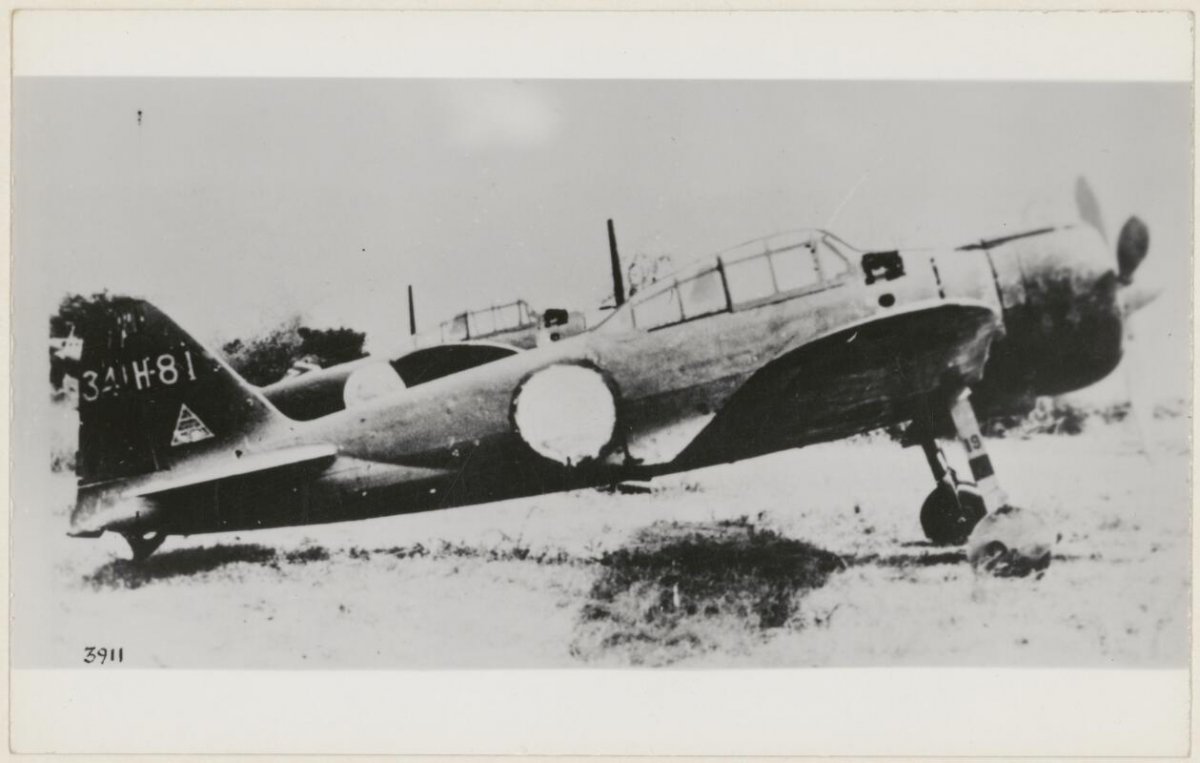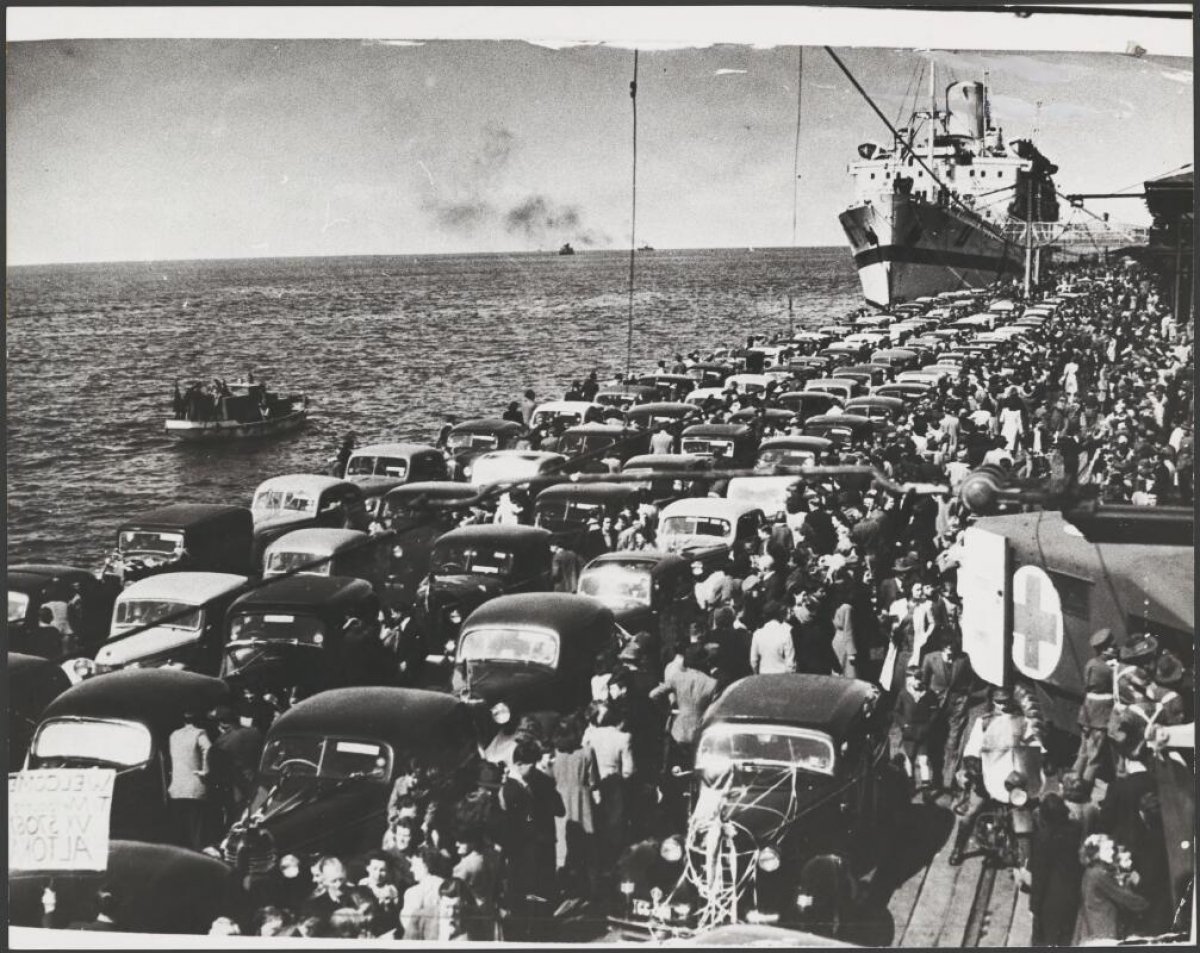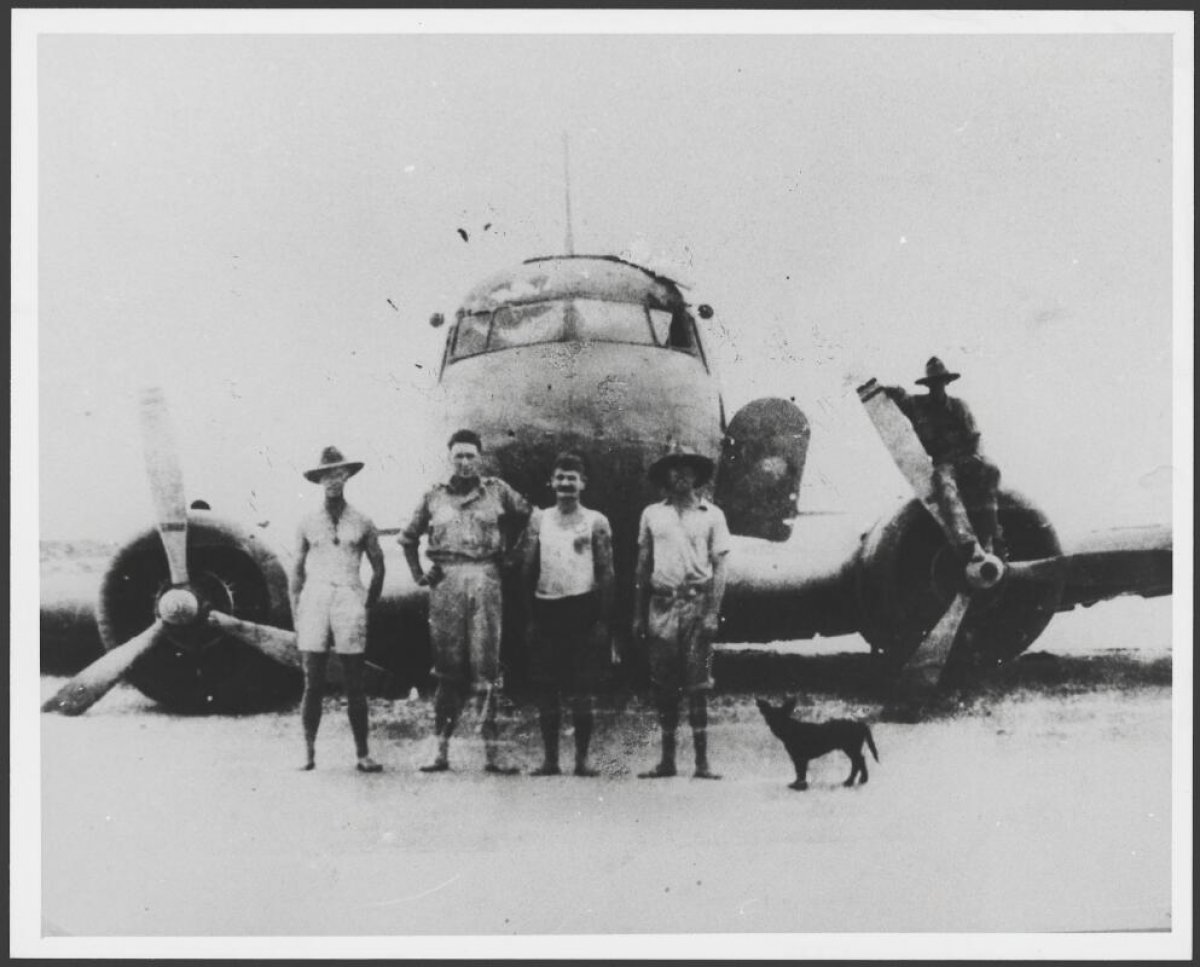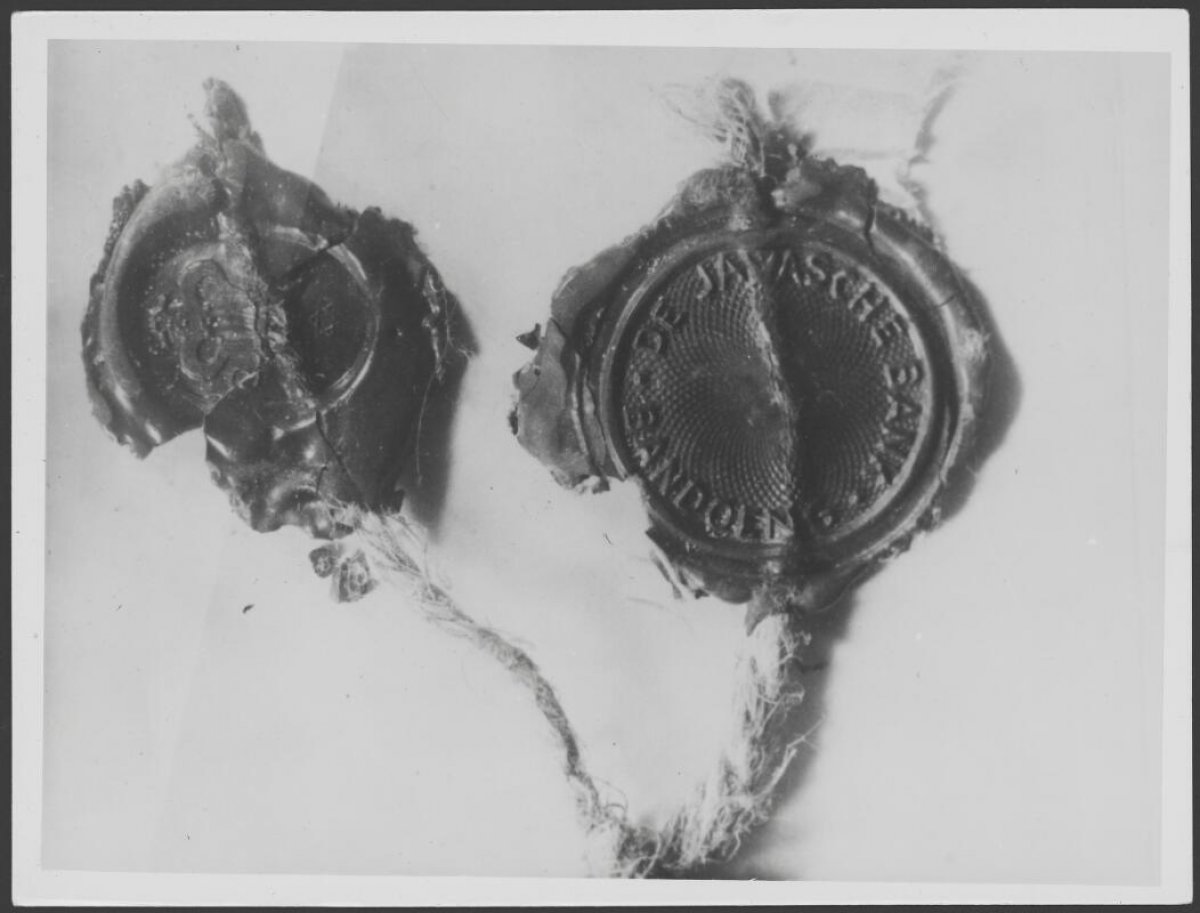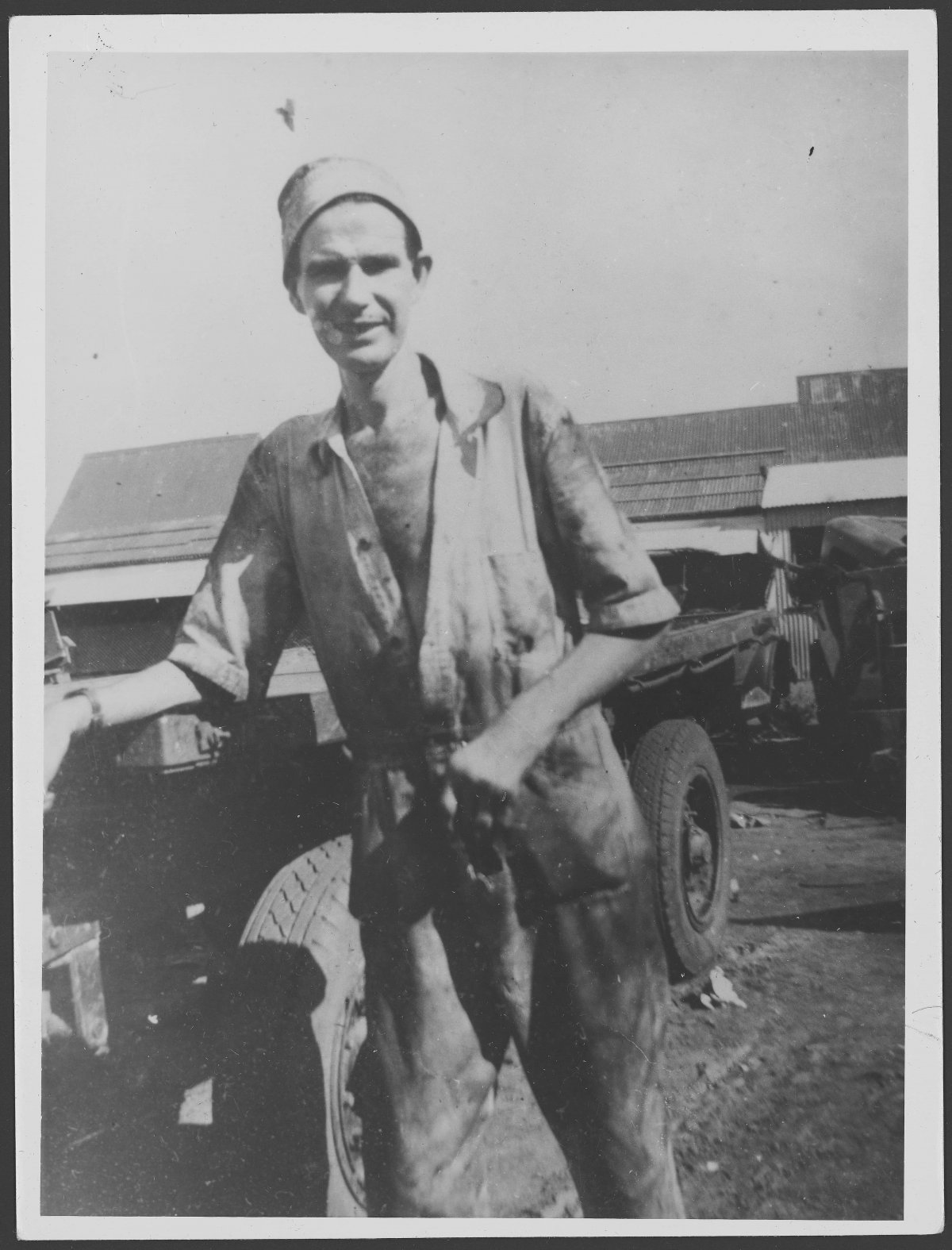This resource has been generously supported by the Embassy of the Kingdom of the Netherlands in Australia, to commemorate the 400th anniversary of the arrival of Dirk Hartog on the West Australian coast in 1616.
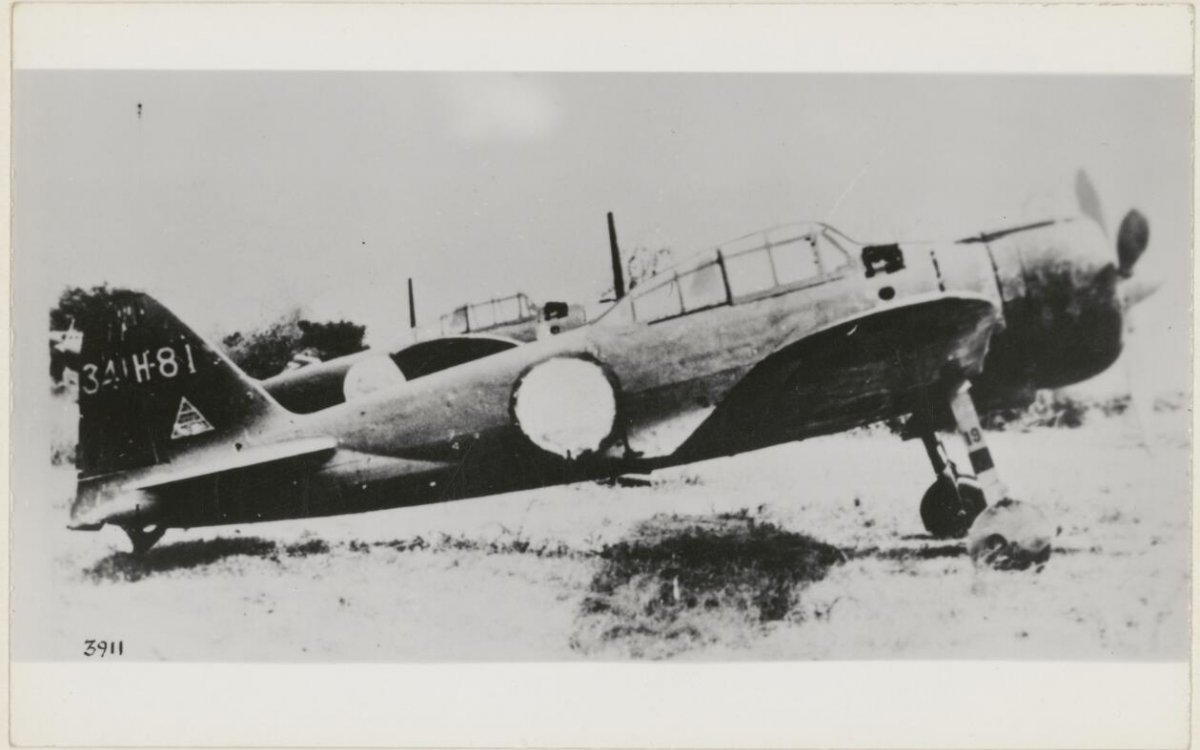
(1940). Mitsubishi A6M Zero-Sen, a Japanese single seat monoplane fighter, ca. 1940 [picture]. http://nla.gov.au/nla.obj-144931273
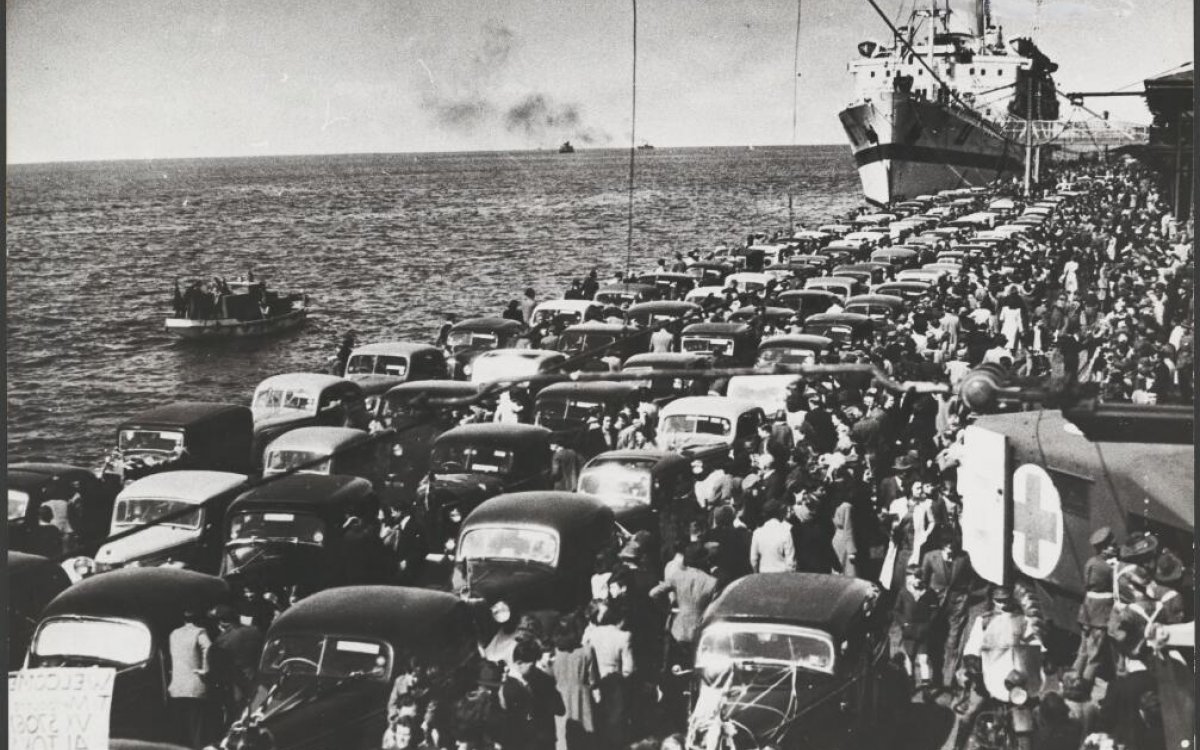
Larkins, John, 1943- Great Australian book of nostalgia. (1945). Dutch Hospital ship Oranje, carrying former prisoners of war, arrives from Singapore at Princes Pier, where the prisoners' relatives have parked their cars upon the pier so that the men would not have far to walk, Melbourne, 1 October 1945 [picture]. http://nla.gov.au/nla.obj-141715966
As World War II broke out across Europe in 1939, the Dutch had initially remained neutral. When Germany occupied the Netherlands in 1940, the Dutch lost the ability to defend their colonies in the Netherlands East Indies.
The Dutch-governed islands to the north of Australia were an essential physical defence between Australia and the looming threat of Japan. The Netherlands and Australia formed a vital alliance, combining forces on land, sea and in the air, in the defence of Australia and the region, as Japan established its foothold in the Pacific.
Despite this alliance, the Netherlands East Indies fell to the Japanese in 1942, giving Japan much needed resources and a valuable naval and air base. Dutch colonials and military staff were put into prisoner-of-war camps, as evacuations hurriedly took place. As the Japanese assumed power, the Netherlands East Indies Government reached an agreement with Australia, and became the only foreign government-in-exile on Australian soil, located for the most part, at Camp Colombia in Queensland.
The Netherlands and Australia forged a considerable friendship. Many Dutch in the region fled to Broome on the north coast of Western Australia. Dutch warships were repaired or stationed in Fremantle. The Netherlands donated hospital ships to Australia, such as the Oranje, pictured here. Several joint units were established, such as the No 18 and No 120 RAAF squadrons.
The bombing of Broome in 1942 brought many Dutch casualties. Having just fled Java, Dutch women and children were waiting in crammed flying boats in Roebuck Bay to refuel before heading to other destinations. When Japanese Zero fighter planes attacked, 76 Dutch nationals were killed. Many others were injured.
Broome was unprepared for the attack, but one man was able to return fire. At Broome’s airbase, Dutch pilot Gus Winckel removed a machine gun from his plane and shot down one of the Japanese planes, sustaining burns to his arm. He later received a medal for his efforts.
As the war concluded, Dutch colonial rule in the region was fading and, after three years of occupation by the Japanese, Indonesia resurrected itself as an independent country, bringing to a close the Dutch hegemony that had lasted nearly 350 years.
As World War II broke out across Europe in 1939, the Dutch had initially remained neutral. When Germany occupied the Netherlands in 1940, the Dutch lost the ability to defend their colonies in the Netherlands East Indies.
The Dutch-governed islands to the north of Australia were an essential physical defence between Australia and the looming threat of Japan. The Netherlands and Australia formed a vital alliance, combining forces on land, sea and in the air, in the defence of Australia and the region, as Japan established its foothold in the Pacific.
Despite this alliance, the Netherlands East Indies fell to the Japanese in 1942, giving Japan much needed resources and a valuable naval and air base. Dutch colonials and military staff were put into prisoner-of-war camps, as evacuations hurriedly took place. As the Japanese assumed power, the Netherlands East Indies Government reached an agreement with Australia, and became the only foreign government-in-exile on Australian soil, located for the most part, at Camp Colombia in Queensland.
The Netherlands and Australia forged a considerable friendship. Many Dutch in the region fled to Broome on the north coast of Western Australia. Dutch warships were repaired or stationed in Fremantle. The Netherlands donated hospital ships to Australia, such as the Oranje, pictured here. Several joint units were established, such as the No 18 and No 120 RAAF squadrons.
The bombing of Broome in 1942 brought many Dutch casualties. Having just fled Java, Dutch women and children were waiting in crammed flying boats in Roebuck Bay to refuel before heading to other destinations. When Japanese Zero fighter planes attacked, 76 Dutch nationals were killed. Many others were injured.
Broome was unprepared for the attack, but one man was able to return fire. At Broome’s airbase, Dutch pilot Gus Winckel removed a machine gun from his plane and shot down one of the Japanese planes, sustaining burns to his arm. He later received a medal for his efforts.
As the war concluded, Dutch colonial rule in the region was fading and, after three years of occupation by the Japanese, Indonesia resurrected itself as an independent country, bringing to a close the Dutch hegemony that had lasted nearly 350 years.
1. Australia was raided by the Japanese approximately 100 times in World War II. Have students research:
- What were the main targets for Japanese attacks and why?
- What aeroplanes were used by the Japanese?
- What contributed to the success of their attacks?
- What were the consequences of the Japanese attacks in Australia?
- How did the Japanese attacks change Australia’s participation in WWII?
2. In March 1942, Java in the Netherlands East Indies was attacked by the Japanese, prompting a hurried evacuation to Broome, in the north of Western Australia. Henk Hasselo was a Netherlands East Indies pilot in World War II, who became a co-pilot of a Dornier plane evacuating people from Java to Broome. However, Broome wasn’t the safe haven they had hoped.
Have students independently listen to 10 minutes of Henk Hasselo’s Oral History (Session 2, from 01:00:09 through to 01:10:00), as he recounts the bombing of Broome.
When listening to his story, students should try to ascertain:
- How did Henk know that the plane was a Japanese Zero?
- Where was he sitting when he saw the planes coming?
- What did he do when the planes started to attack?
- What was Henk’s injury during the attack?
- Who was swimming in the water? What did Henk do?
- What exactly were the Japanese attacking?
Henk’s interview is a primary source. Encourage students to locate other primary sources about the bombing of Broome, using the catalogue of the National Library of Australia, and collections in other keeping places such as the Australian War Memorial and the National Archives of Australia.
3. During the Bombing of Broome, another Dutch pilot, Gus Winckel was at the airport with his plane. He was able to successfully return fire in the Japanese attack.
Using Trove, task students with finding and reading articles that appeared in newspapers in the days after the bombing of Broome, including the story of Gus Winckel. In accessing these secondary sources, students should think about:
- Why do you think the exact same information is repeated in some articles?
- Where did the original information come from?
- How do you think information changes when published in a newspaper?
- How would the war affect the information being published in newspapers?
- How do primary sources (such as Henk’s interview) differ to secondary sources, in their ability to convey what actually happened that day?
4. Students will have also encountered a range of identities, who experienced first-hand, the bombing on 3 March 1942. Choosing one real-life identity discovered in their research (such as Henk Hasselo, Gus Winckel, and any of the eye-witnesses encountered in the newspaper articles), have students write a modern-day letter as that person, to their grandchild. They should not only recount events of that day, but write about how life has changed because of their experience, reflecting on their own life, and also how Australia changed as a result of the attack.
The Case of the Carnot Bay Missing Diamonds
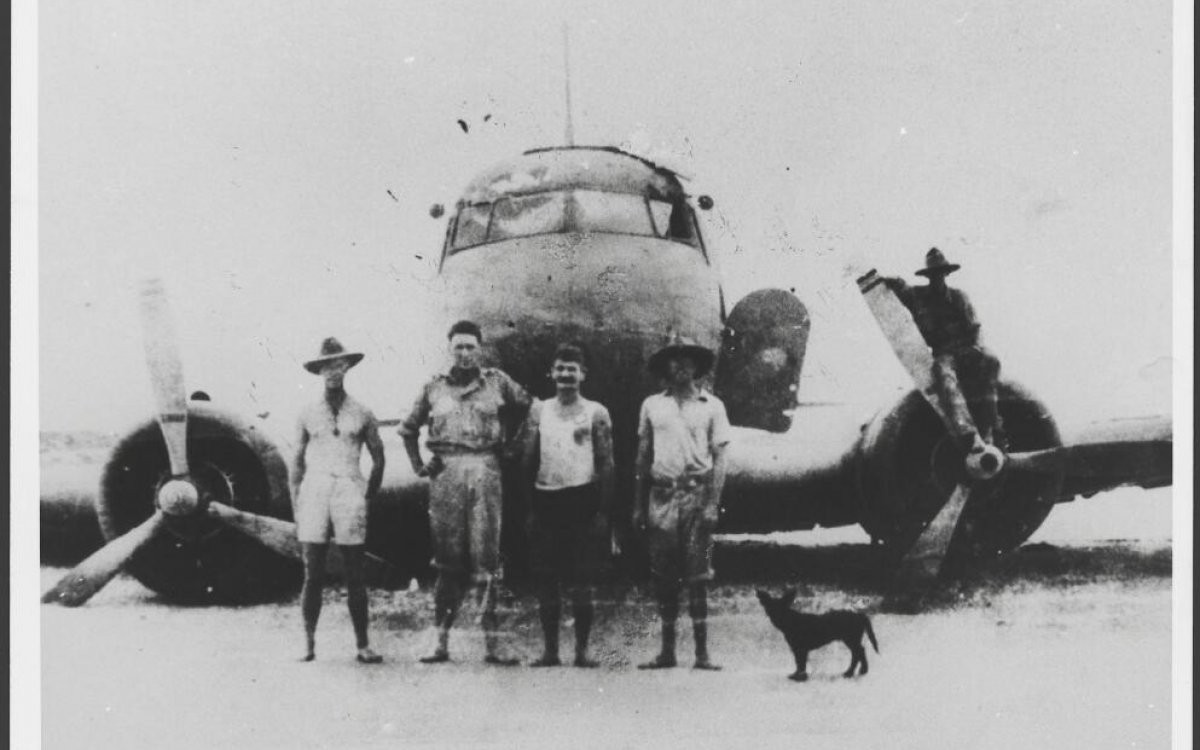
(1942). Investigating party standing in front of crashed Netherlands East Indies KLM Dakota DC-3 passenger transport PK-AFV 'Pelikaan' at Carnot Bay, Lieutenant Laurie O'Neil (second from left), 'Diamond' Jack Palmer (third from left) and Warrant Officer Gus Clinch (fourth from left), Western Australia, March 1942 [picture]. http://nla.gov.au/nla.obj-148197066
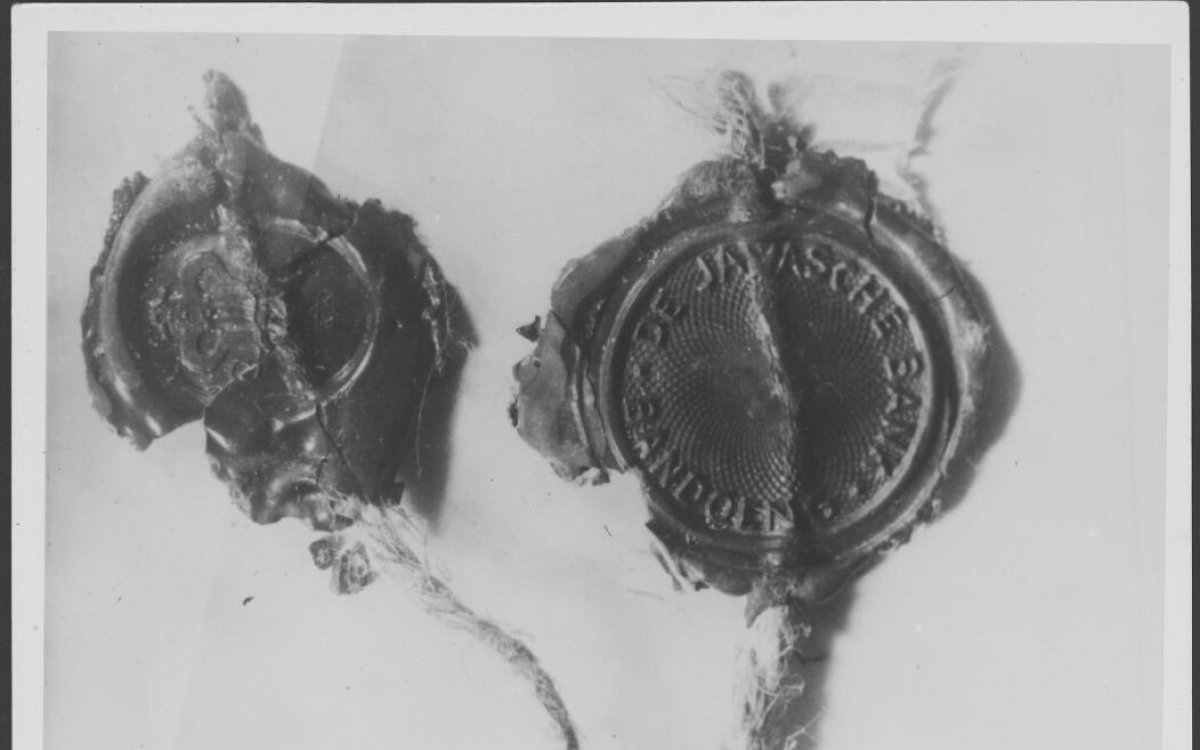
(1942). Dutch Javasche Bank wax seal from packet of diamonds that went missing after Dutch DC-3 transport aeroplane was shot down, Broome, Western Australia, 1942 [picture]. http://nla.gov.au/nla.obj-148194901
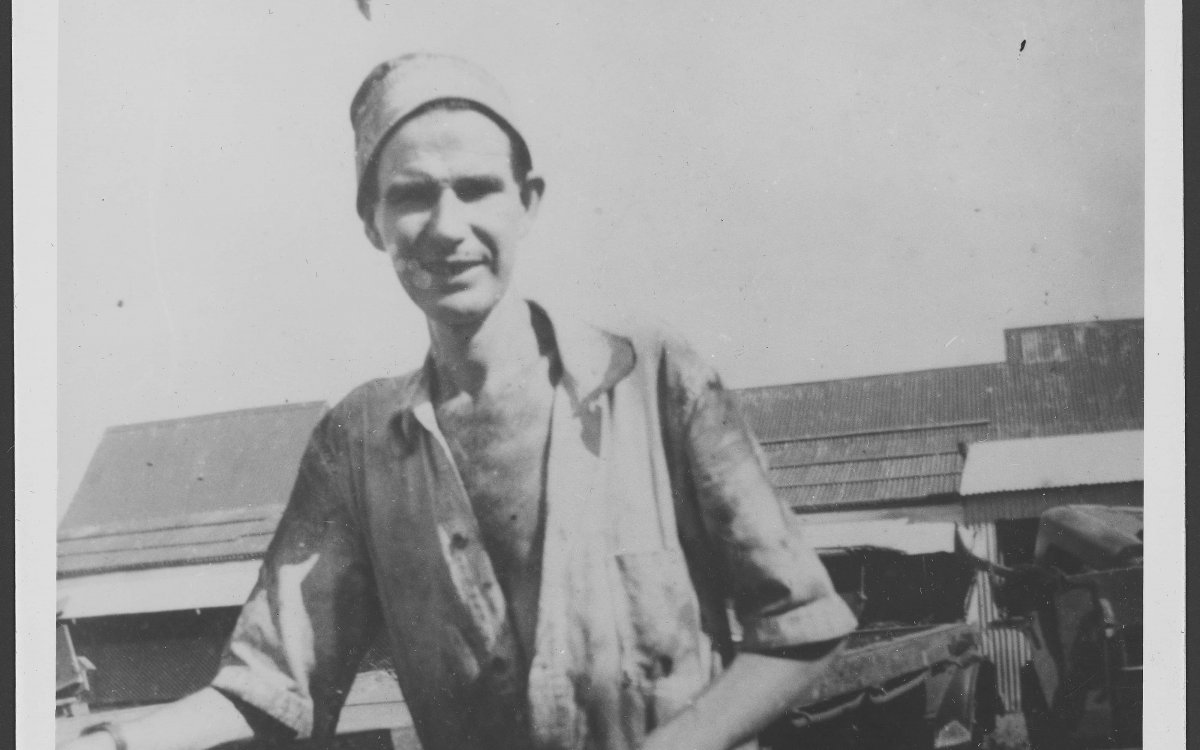
(1942). Unidentified man next to a truck holding an empty Dutch Javasche Bank diamond bag, 1942 [picture]. http://nla.gov.au/nla.obj-148198315
On 3 March 1942, PK-AFV Pelikaan, a Dutch airliner piloted by Russian WW1 flying ace Captain Smirnoff, was evacuating military personnel and civilian passengers from Bandung in the Netherlands East Indies. Just before its early morning departure, Captain Smirnoff was approached by the airport station manager with a package, wax-sealed by the Dutch Javasche Bank, and instructed to hand it to a representative of the Commonwealth Bank once he reached Australia.
The Japanese Zeros returning to Timor, having just completed their air raid on Broome, were surprised to find the Dutch airliner below them in the sky. They shot down the plane, which crash-landed in the surf at Carnot Bay, about 80 kilometres north of Broome.
Having survived the crash, four passengers were killed, including a mother and her eighteen-month-old baby, when the Japanese returned to strafe the plane. The next day, the Japanese returned to bomb the plane and the survivors, however no further lives were lost. After six days on the beach, the Dutch crew and remaining passengers were rescued by a party from Beagle Bay.
But what of the package handed to Captain Smirnoff before departure? The parcel contained £300,000 worth of diamonds, the equivalent of around $20 million in today’s money. While Smirnoff claims he never knew what the package contained and that it had been lost in the surf, others claim he knew of the package contents and intended to retrieve them. Jack Palmer, a Broome local who visited the crash site days after the rescue, later handed in a number of diamonds, but they were only a small percentage of the entire package. He said that he had found the bag at the crash site, but that most of the diamonds had fallen out, lost to the sand.
Palmer and two colleagues, Frank Robinson and James Mulgrue, were tried and acquitted of diamond theft. Others claim the diamonds were circulated among the local Indigenous children and yet other stories suggest they were found in the fork of a tree, in a fireplace and in the possession of a Chinese trader.
No-one has ever been convicted of the diamond theft, and today the whereabouts of the diamonds are still unknown.
On 3 March 1942, PK-AFV Pelikaan, a Dutch airliner piloted by Russian WW1 flying ace Captain Smirnoff, was evacuating military personnel and civilian passengers from Bandung in the Netherlands East Indies. Just before its early morning departure, Captain Smirnoff was approached by the airport station manager with a package, wax-sealed by the Dutch Javasche Bank, and instructed to hand it to a representative of the Commonwealth Bank once he reached Australia.
The Japanese Zeros returning to Timor, having just completed their air raid on Broome, were surprised to find the Dutch airliner below them in the sky. They shot down the plane, which crash-landed in the surf at Carnot Bay, about 80 kilometres north of Broome.
Having survived the crash, four passengers were killed, including a mother and her eighteen-month-old baby, when the Japanese returned to strafe the plane. The next day, the Japanese returned to bomb the plane and the survivors, however no further lives were lost. After six days on the beach, the Dutch crew and remaining passengers were rescued by a party from Beagle Bay.
But what of the package handed to Captain Smirnoff before departure? The parcel contained £300,000 worth of diamonds, the equivalent of around $20 million in today’s money. While Smirnoff claims he never knew what the package contained and that it had been lost in the surf, others claim he knew of the package contents and intended to retrieve them. Jack Palmer, a Broome local who visited the crash site days after the rescue, later handed in a number of diamonds, but they were only a small percentage of the entire package. He said that he had found the bag at the crash site, but that most of the diamonds had fallen out, lost to the sand.
Palmer and two colleagues, Frank Robinson and James Mulgrue, were tried and acquitted of diamond theft. Others claim the diamonds were circulated among the local Indigenous children and yet other stories suggest they were found in the fork of a tree, in a fireplace and in the possession of a Chinese trader.
No-one has ever been convicted of the diamond theft, and today the whereabouts of the diamonds are still unknown.
1. Show students, the primary sources in the collection of the National Library of Australia, relevant to the case of the missing diamonds at Carnot Bay. Using Trove, have students research the event, and in doing so, have them identify a list of facts and evidence that they know about the case to be true.
2. Students can then write an account, arguing for one particular theory about what happened to the diamonds at Carnot Bay. They should identify the various other possible scenarios and give reasons as to why each other theory is not plausible. They should make specific reference to the evidence available to them in writing their account.
